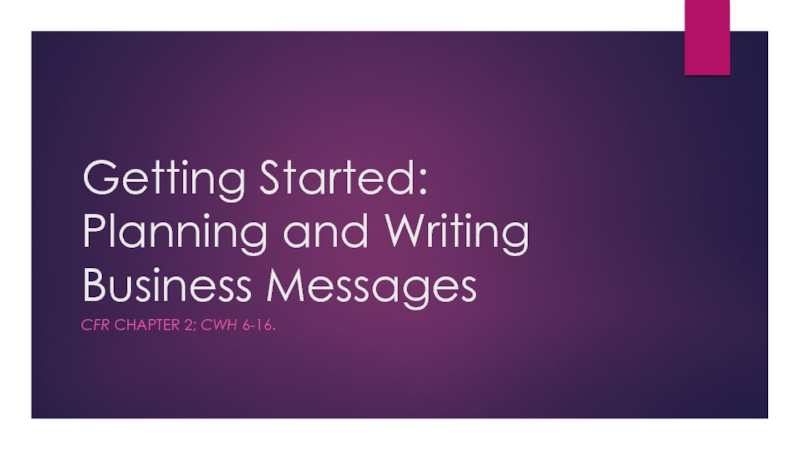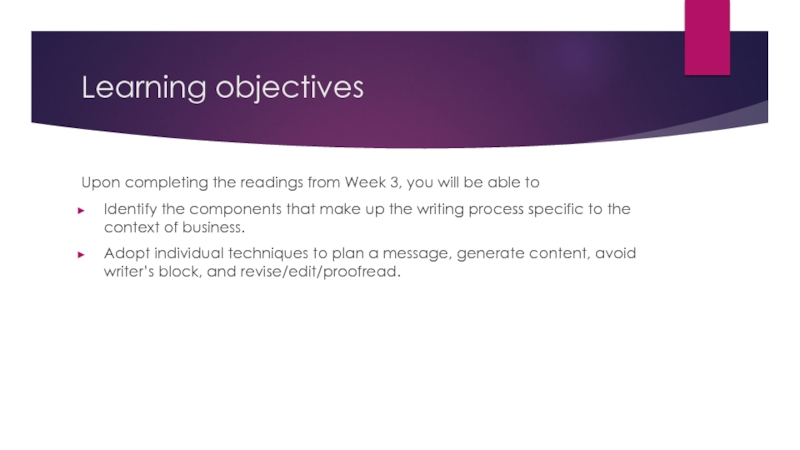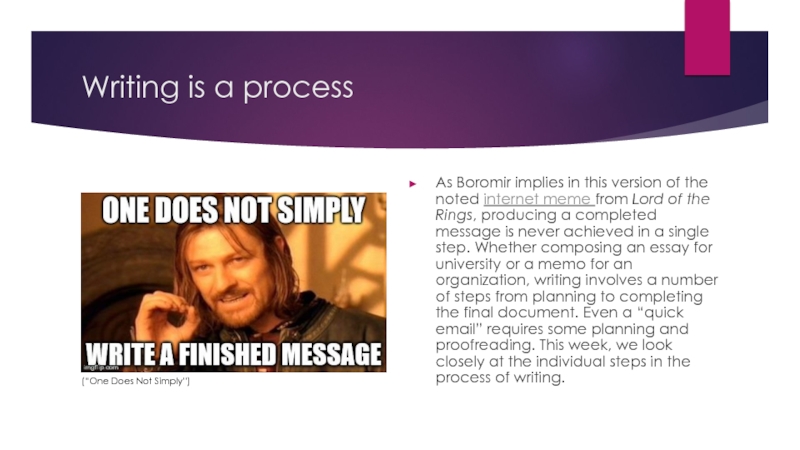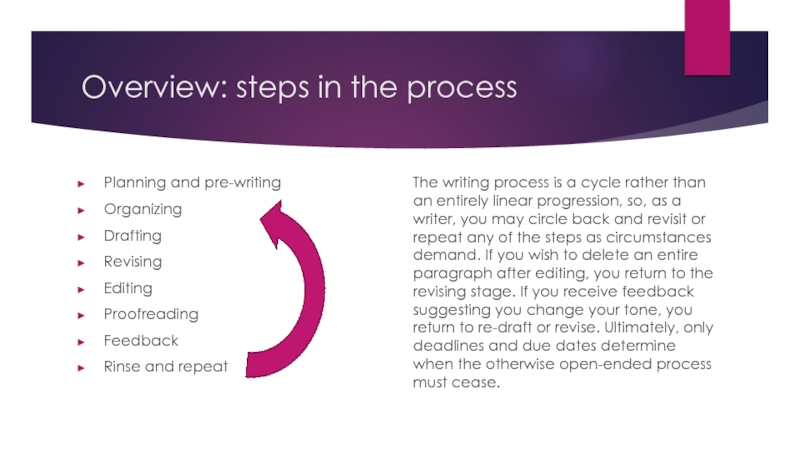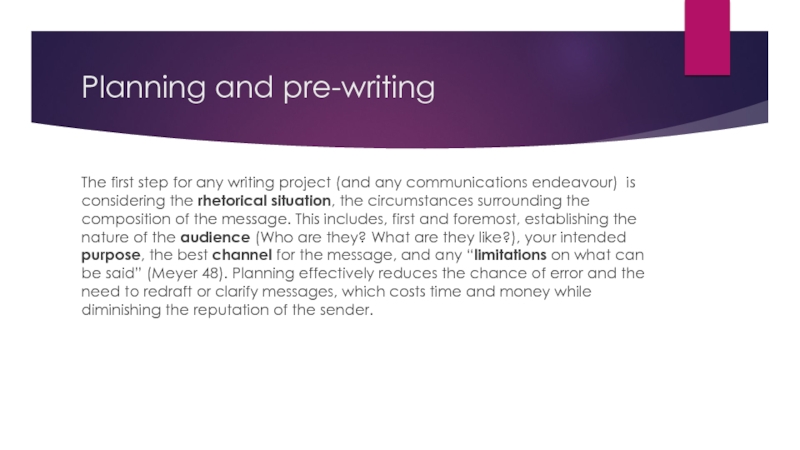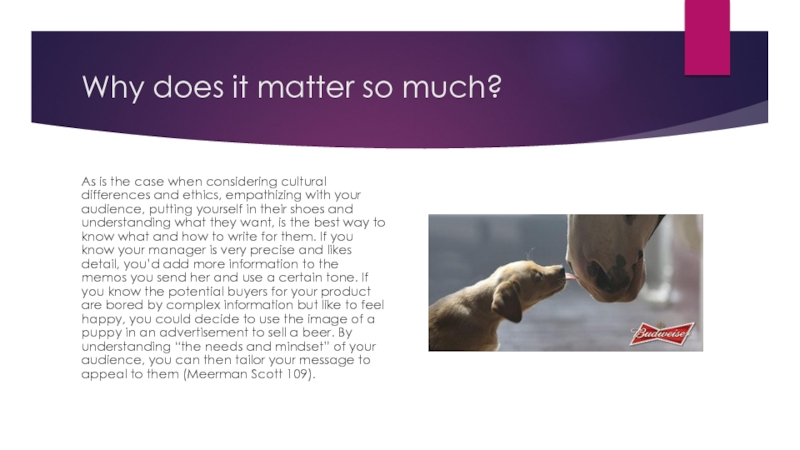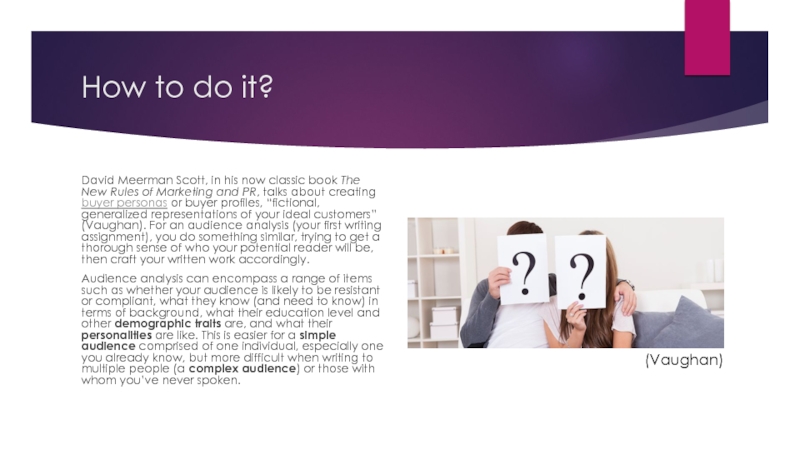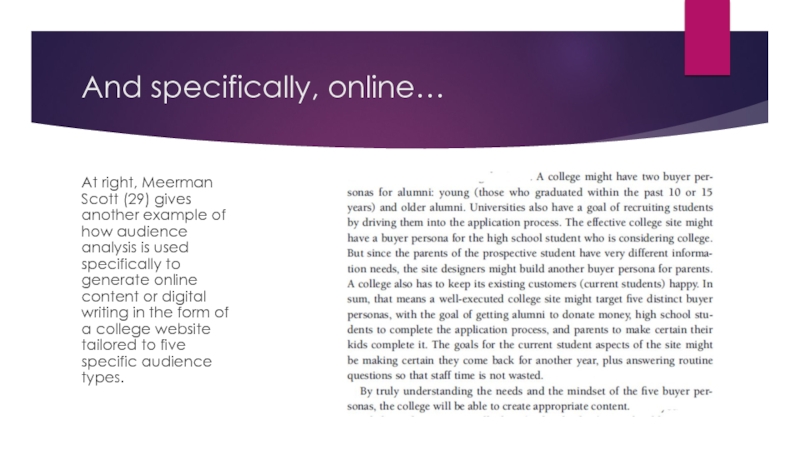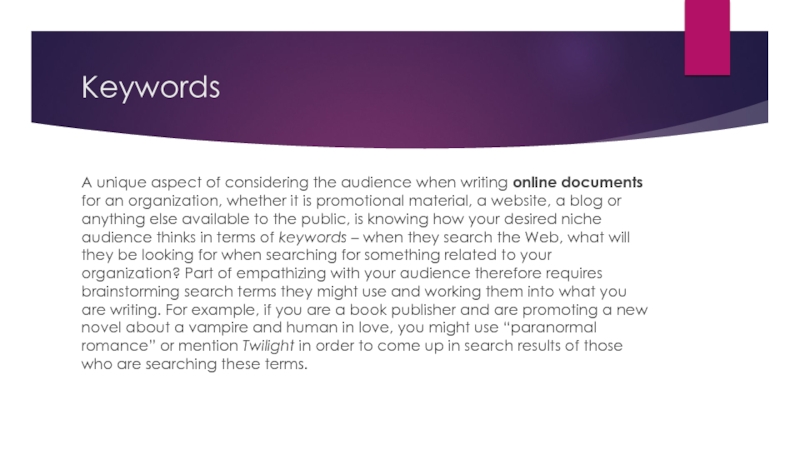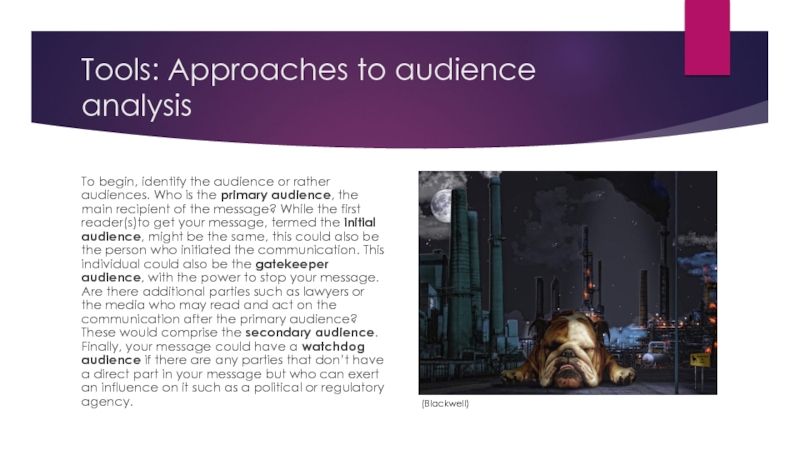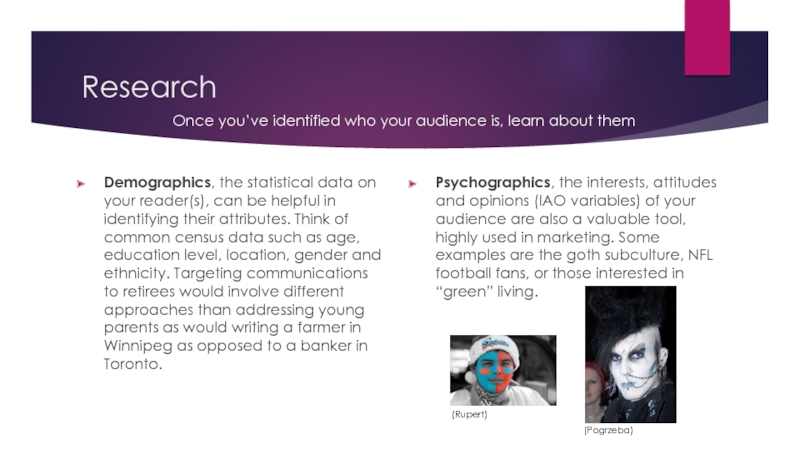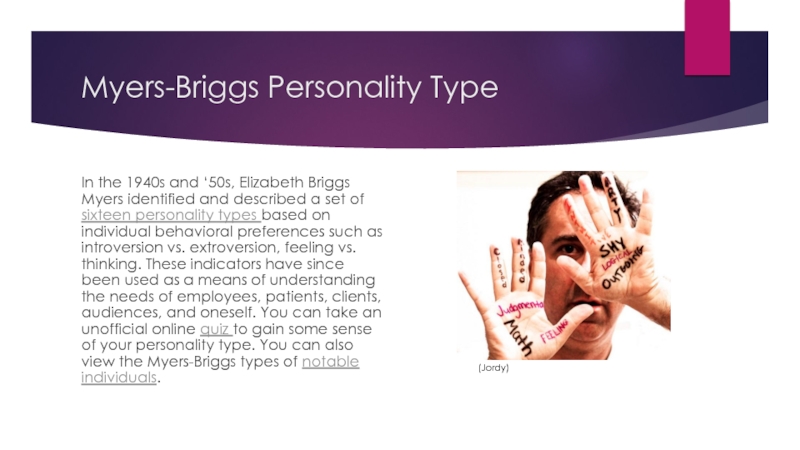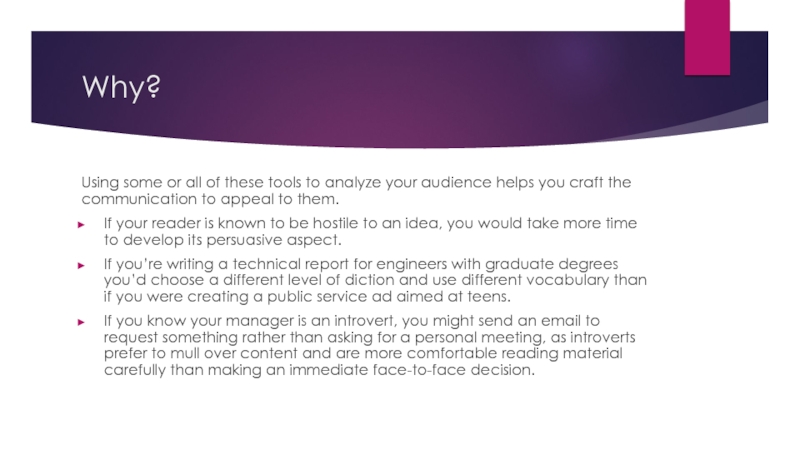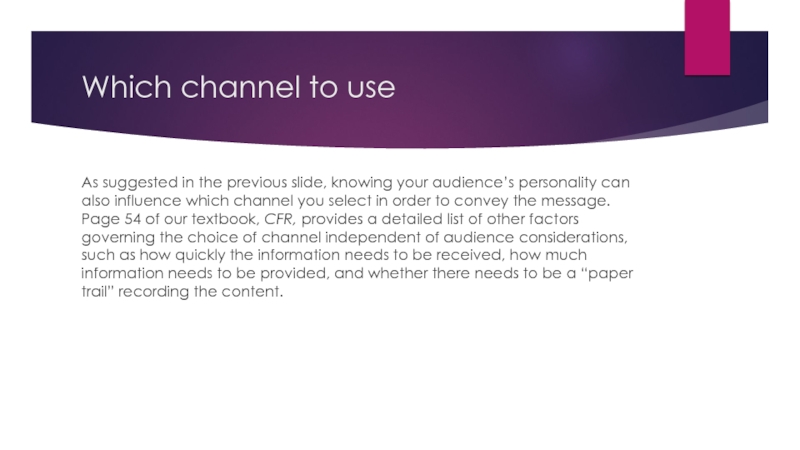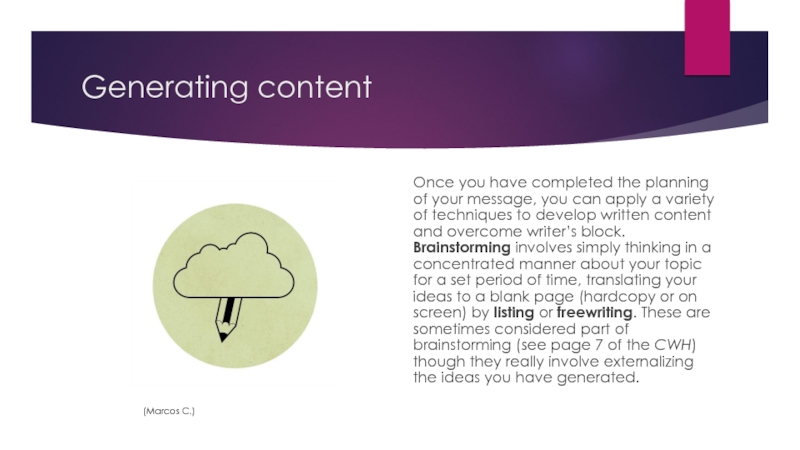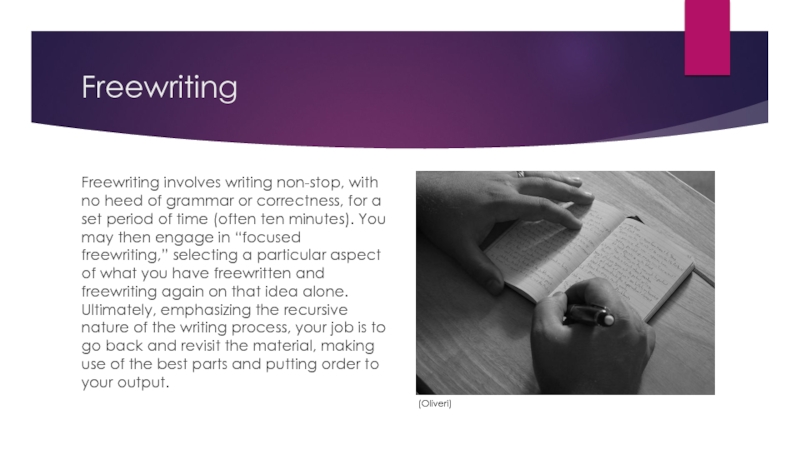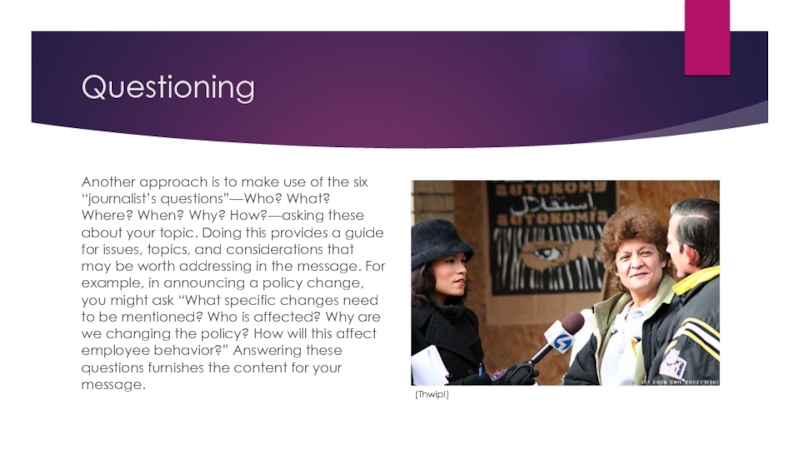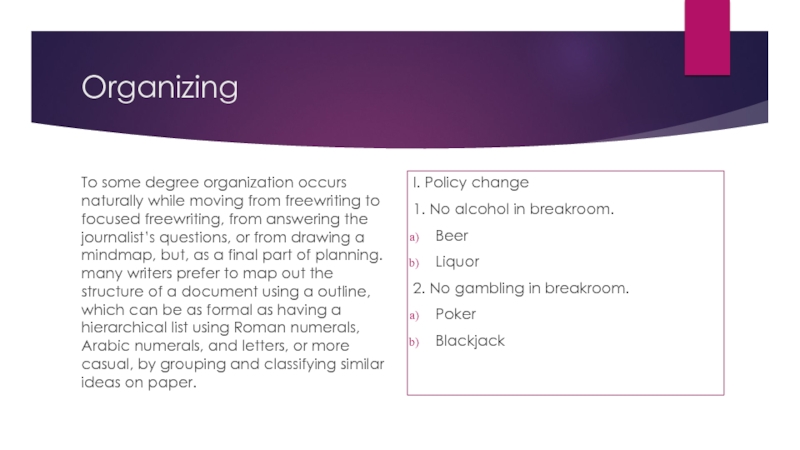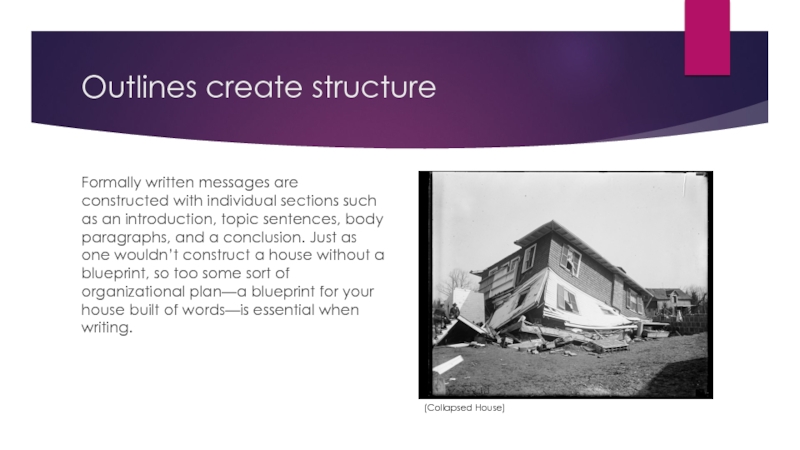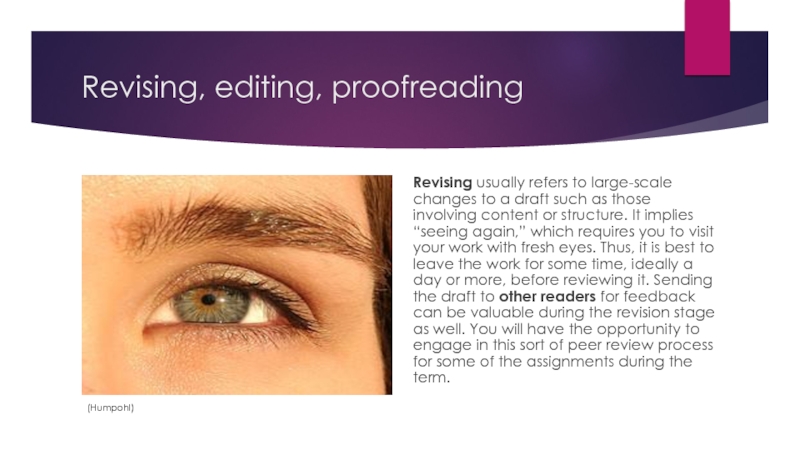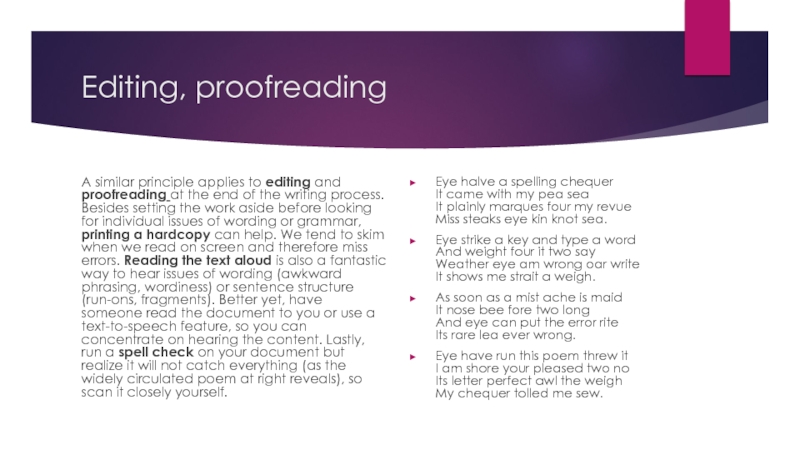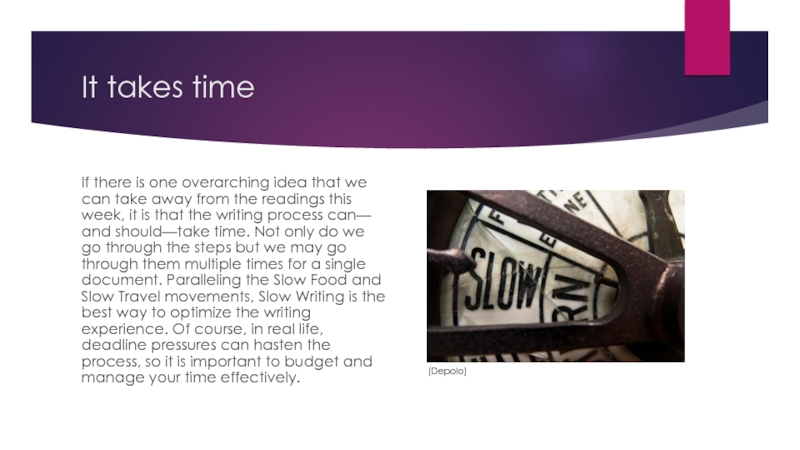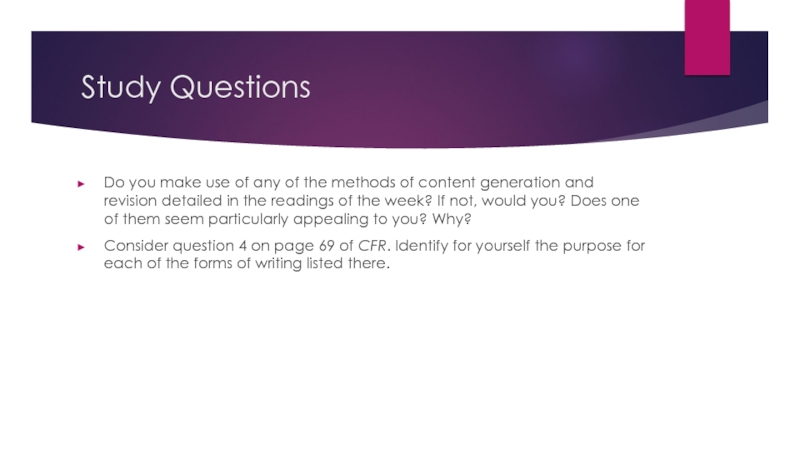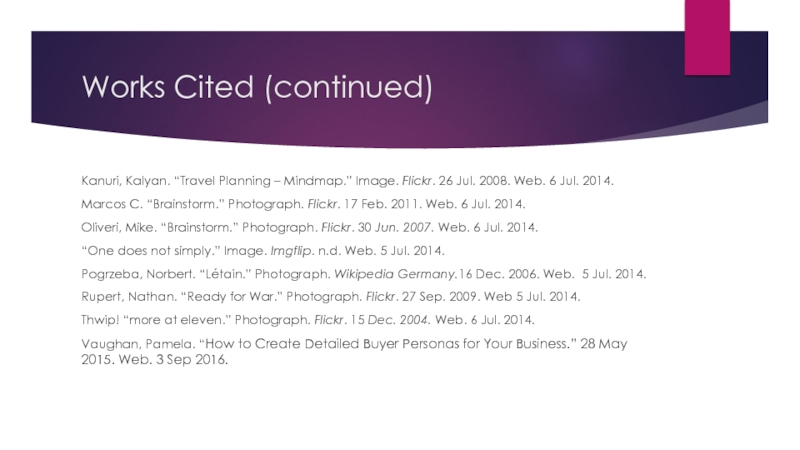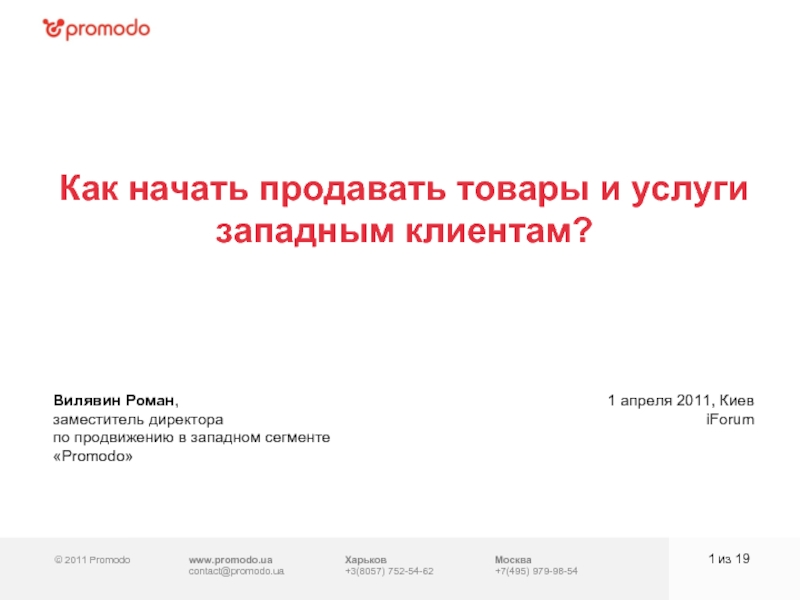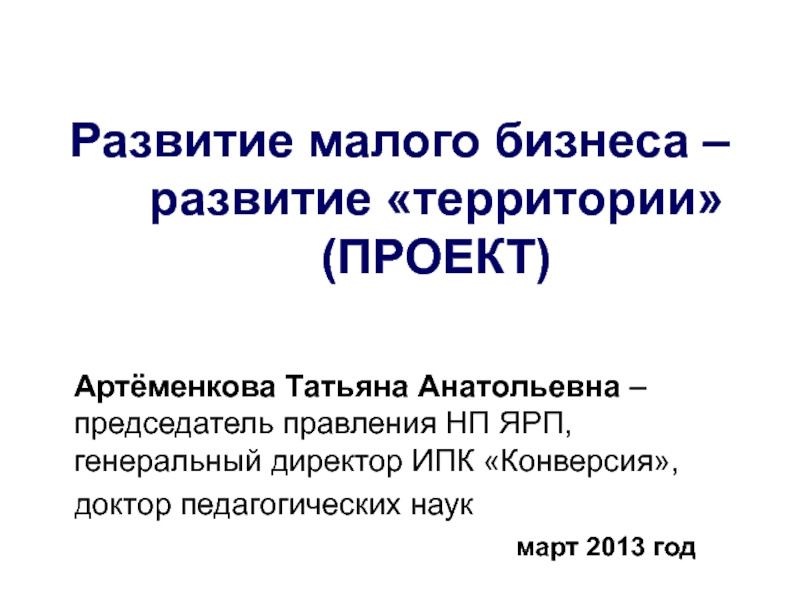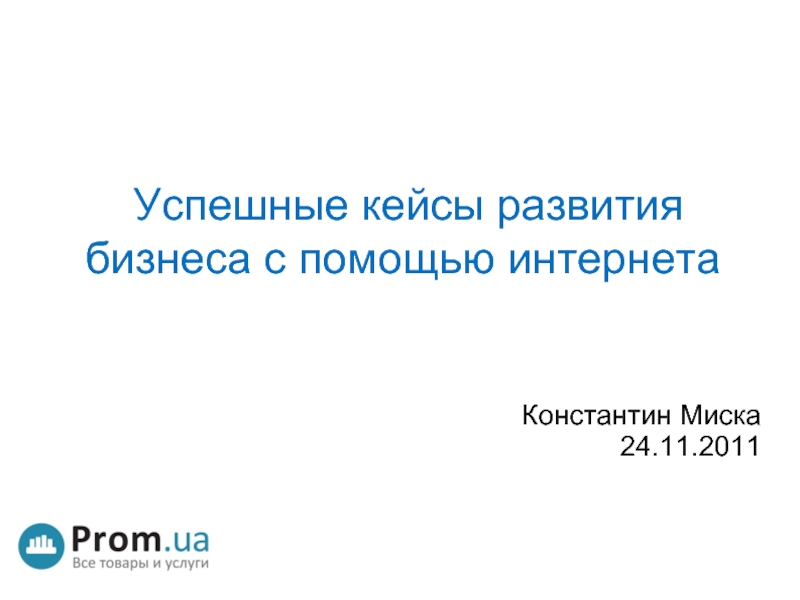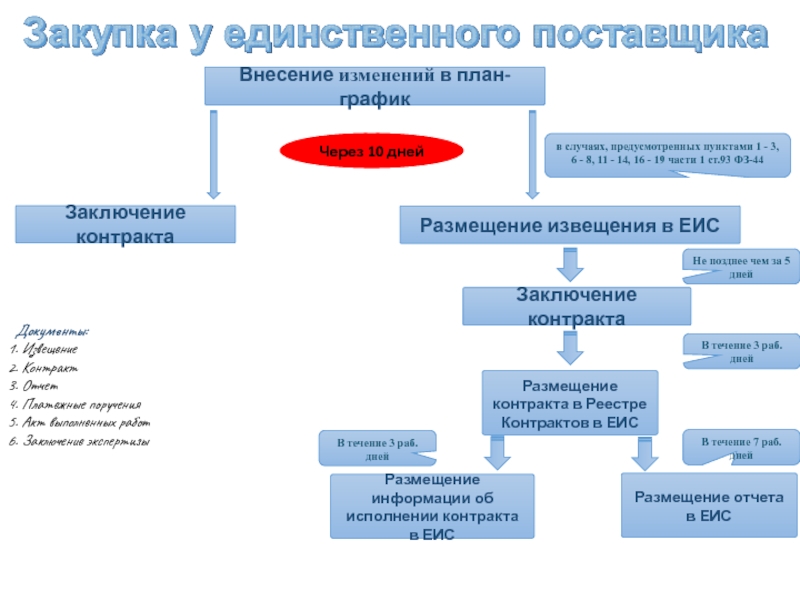- Главная
- Разное
- Дизайн
- Бизнес и предпринимательство
- Аналитика
- Образование
- Развлечения
- Красота и здоровье
- Финансы
- Государство
- Путешествия
- Спорт
- Недвижимость
- Армия
- Графика
- Культурология
- Еда и кулинария
- Лингвистика
- Английский язык
- Астрономия
- Алгебра
- Биология
- География
- Детские презентации
- Информатика
- История
- Литература
- Маркетинг
- Математика
- Медицина
- Менеджмент
- Музыка
- МХК
- Немецкий язык
- ОБЖ
- Обществознание
- Окружающий мир
- Педагогика
- Русский язык
- Технология
- Физика
- Философия
- Химия
- Шаблоны, картинки для презентаций
- Экология
- Экономика
- Юриспруденция
Getting Started: Planning and Writing Business Messages презентация
Содержание
- 1. Getting Started: Planning and Writing Business Messages
- 2. Learning objectives Upon completing the readings from
- 3. Writing is a process As Boromir implies
- 4. Overview: steps in the process Planning and
- 5. Planning and pre-writing The first step for
- 6. Purpose Within the rhetorical situation, the first
- 7. Know the audience: The most important consideration
- 8. Why does it matter so much? As
- 9. How to do it? David Meerman Scott,
- 10. Online Audiences Analyzing your audience may seem
- 11. Examples David Meerman Scott gives a concrete
- 12. And specifically, online… At right, Meerman Scott
- 13. Keywords A unique aspect of considering the
- 14. Tools: Approaches to audience analysis To begin,
- 15. Research Demographics, the statistical data on your
- 16. Myers-Briggs Personality Type In the 1940s and
- 17. Why? Using some or all of these
- 18. Which channel to use As suggested in
- 19. Generating content Once you have completed the
- 20. Freewriting Freewriting involves writing non-stop, with no
- 21. Questioning Another approach is to make use
- 22. Mindmapping If you are a visual learner,
- 23. Organizing To some degree organization occurs naturally
- 24. Outlines create structure Formally written messages are
- 25. Drafting and Revision When planning ends, writing
- 26. Beating writer’s block A major cause of
- 27. Beating writer’s block Another tip is to
- 28. Revising, editing, proofreading Revising usually refers
- 29. Editing, proofreading A similar principle applies to
- 30. It takes time If there is one
- 31. Study Questions Do you make use of
- 32. Works Cited Albaih, Khalid. “Waiting.” Illustration. Flickr.
- 33. Works Cited (continued) Kanuri, Kalyan. “Travel Planning
Слайд 2Learning objectives
Upon completing the readings from Week 3, you will be
Identify the components that make up the writing process specific to the context of business.
Adopt individual techniques to plan a message, generate content, avoid writer’s block, and revise/edit/proofread.
Слайд 3Writing is a process
As Boromir implies in this version of the
(“One Does Not Simply”)
Слайд 4Overview: steps in the process
Planning and pre-writing
Organizing
Drafting
Revising
Editing
Proofreading
Feedback
Rinse and repeat
The writing process
Слайд 5Planning and pre-writing
The first step for any writing project (and any
Слайд 6Purpose
Within the rhetorical situation, the first consideration when writing is determining
Слайд 7Know the audience: The most important consideration
In case you hadn’t noticed
Purpose and audience are usually the two foundational aspects to think about when preparing to write. It’s fairly easy to know your purpose—you know if you have to give bad news or if you need to persuade. Knowing the audience can be more challenging, and given how crucial it is for all the professional writing you do, we’re going to take some time to talk about how to do this in depth here.
(Ganzer)
Слайд 8Why does it matter so much?
As is the case when considering
Слайд 9How to do it?
David Meerman Scott, in his now classic book
Audience analysis can encompass a range of items such as whether your audience is likely to be resistant or compliant, what they know (and need to know) in terms of background, what their education level and other demographic traits are, and what their personalities are like. This is easier for a simple audience comprised of one individual, especially one you already know, but more difficult when writing to multiple people (a complex audience) or those with whom you’ve never spoken.
(Vaughan)
Слайд 10Online Audiences
Analyzing your audience may seem particularly daunting when writing online
You can’t realistically or effectively target the entire Web with what you write but instead need to tailor digital content to particular niche audience. For example, instead of blogging about cars, you might write a blog for Canadian owners of the second-generation Mazda 3 automobile. Odds are that more general content will not be found or will be buried online while the specific focus, the niche topic, will be found more easily by a certain audience.
Слайд 11Examples
David Meerman Scott gives a concrete example of how a targeted
Слайд 12And specifically, online…
At right, Meerman Scott (29) gives another example of
Слайд 13Keywords
A unique aspect of considering the audience when writing online documents
Слайд 14Tools: Approaches to audience analysis
To begin, identify the audience or rather
(Blackwell)
Слайд 15Research
Demographics, the statistical data on your reader(s), can be helpful in
Psychographics, the interests, attitudes and opinions (IAO variables) of your audience are also a valuable tool, highly used in marketing. Some examples are the goth subculture, NFL football fans, or those interested in “green” living.
Once you’ve identified who your audience is, learn about them
(Rupert)
(Pogrzeba)
Слайд 16Myers-Briggs Personality Type
In the 1940s and ‘50s, Elizabeth Briggs Myers identified
(Jordy)
Слайд 17Why?
Using some or all of these tools to analyze your audience
If your reader is known to be hostile to an idea, you would take more time to develop its persuasive aspect.
If you’re writing a technical report for engineers with graduate degrees you’d choose a different level of diction and use different vocabulary than if you were creating a public service ad aimed at teens.
If you know your manager is an introvert, you might send an email to request something rather than asking for a personal meeting, as introverts prefer to mull over content and are more comfortable reading material carefully than making an immediate face-to-face decision.
Слайд 18Which channel to use
As suggested in the previous slide, knowing your
Слайд 19Generating content
Once you have completed the planning of your message, you
(Marcos C.)
Слайд 20Freewriting
Freewriting involves writing non-stop, with no heed of grammar or correctness,
(Oliveri)
Слайд 21Questioning
Another approach is to make use of the six “journalist’s questions”—Who?
(Thwip!)
Слайд 22Mindmapping
If you are a visual learner, mind-mapping (also known variously as
(Kaluri)
Слайд 23Organizing
To some degree organization occurs naturally while moving from freewriting to
I. Policy change
1. No alcohol in breakroom.
Beer
Liquor
2. No gambling in breakroom.
Poker
Blackjack
Слайд 24Outlines create structure
Formally written messages are constructed with individual sections such
(Collapsed House)
Слайд 25Drafting and Revision
When planning ends, writing (drafting) and rewriting (revision) take
During drafting and revising it is not uncommon for writer’s block to occur. Our text (Meyer 59-60) provides some useful advice on getting around this.
(Coleman)
Слайд 26Beating writer’s block
A major cause of writer’s block while drafting (or
Editing should occur later as a distinct step once the higher-order matters are completed to your satisfaction. However, the ease of editing using word processing software makes it tempting to do so while still in the middle of drafting or revising. This can be a wasted effort if you later delete a large chunk of text you’ve spent time editing in addition to being a major cause of writer’s block. So, leave the lower-order, micro concerns for later.
Слайд 27Beating writer’s block
Another tip is to escape writer’s block is to
Alternatively, skip to another section in the work. If you are having difficulty drafting the introduction, do the body first. There’s no rule that you need to progress through the document in linear order.
If all else fails, try freewriting again as a way to generate content in the middle of the drafting process.
(Albaih)
Слайд 28Revising, editing, proofreading
Revising usually refers to large-scale changes to a draft
(Humpohl)
Слайд 29Editing, proofreading
A similar principle applies to editing and proofreading at the
Eye halve a spelling chequer
It came with my pea sea
It plainly marques four my revue
Miss steaks eye kin knot sea.
Eye strike a key and type a word
And weight four it two say
Weather eye am wrong oar write
It shows me strait a weigh.
As soon as a mist ache is maid
It nose bee fore two long
And eye can put the error rite
Its rare lea ever wrong.
Eye have run this poem threw it
I am shore your pleased two no
Its letter perfect awl the weigh
My chequer tolled me sew.
Слайд 30It takes time
If there is one overarching idea that we can
(Depolo)
Слайд 31Study Questions
Do you make use of any of the methods of
Consider question 4 on page 69 of CFR. Identify for yourself the purpose for each of the forms of writing listed there.
Слайд 32Works Cited
Albaih, Khalid. “Waiting.” Illustration. Flickr. 12 Sep. 2012. Web. 6
Blackwell, David. “Silvester the Guard Dog.” Photograph. Flickr. 14 Apr. 2012. Web. 5 Jul. 2014.
Collapsed house. Harris & Ewing. Photograph. Library of Congress. 1923. Web. 6 Jul. 2014.
Coleman, Marie. “2.19.10.” Photograph. Flickr. 19 Feb. 2010. Web. 6 Jul. 2014.
Depolo, Steven. “SLOW.” Photograph. Flickr. 24 Apr. 2010. Web. 6 Jul. 2014.
Ganzer, Rupert. “KOL Audience.” Photograph. Flickr. 9 Dec. 2010. Web. 5 Jul. 2014.
Humpohl, David. “eye see you.” Photograph. Flickr. 30 Oct. 2005. Web. 6 Jul. 2014.
Jordy. “I Will Not Be Graphed.” Photograph. Flickr. 22 Sep. 2008. Web. 5 Jul. 2014.
Meerman Scott, David. The New Rules of Marketing and PR. New York: Wiley, 2013. Print.
Meyer, Carolyn. Communicating for Results: A Canadian Student’s Guide. Don Mills: Oxford UP, 2014.
Слайд 33Works Cited (continued)
Kanuri, Kalyan. “Travel Planning – Mindmap.” Image. Flickr. 26
Marcos C. “Brainstorm.” Photograph. Flickr. 17 Feb. 2011. Web. 6 Jul. 2014.
Oliveri, Mike. “Brainstorm.” Photograph. Flickr. 30 Jun. 2007. Web. 6 Jul. 2014.
“One does not simply.” Image. Imgflip. n.d. Web. 5 Jul. 2014.
Pogrzeba, Norbert. “Létain.” Photograph. Wikipedia Germany.16 Dec. 2006. Web. 5 Jul. 2014.
Rupert, Nathan. “Ready for War.” Photograph. Flickr. 27 Sep. 2009. Web 5 Jul. 2014.
Thwip! “more at eleven.” Photograph. Flickr. 15 Dec. 2004. Web. 6 Jul. 2014.
Vaughan, Pamela. “How to Create Detailed Buyer Personas for Your Business.” 28 May 2015. Web. 3 Sep 2016.
